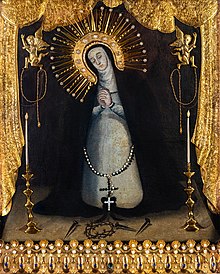| Our Lady of Solitude of Porta Vaga Nuestra Señora de la Soledad de Porta Vaga Mahal na Birhen ng Soledad ng Porta Vaga | |
|---|---|
 The original icon | |
| Location | Cavite City, Philippines |
| Date | 1667 |
| Witness | Soldier |
| Type | Marian apparition |
| Approval | 19 March 2018, Canonical coronation by Pope Francis |
| Venerated in | Catholic Church Philippine Independent Church |
| Shrine | Diocesan Shrine of Our Lady of Solitude of Porta Vaga, San Roque Parish Church, Cavite City, Philippines |
| Patronage | Province of Cavite Cavite City Galleons Navigators Travellers Sailors Vocations Marines Navy Tahanan ng Mabuting Pastol Seminary, Tagaytay |
| Attributes | Oil painting on canvas approx. 18-1/8" x 14-3/4" Aureola with 24 stars made from diamonds. a Rosary, made from pearls and a Cross of diamonds. Crown of Thorns and Nails symbols of Christ's Passion. Gold and silver Riza in the shape of candle sticks, angels, Curtains, Shells and multiple precious gems. |
| Feast day | 2nd and 3rd Sunday of November |
Our Lady of Solitude of Porta Vaga (Spanish: Nuestra Señora de la Soledad de Porta Vaga, Filipino: Mahal na Birhen ng Soledad ng Porta Vaga) also known as the Virgin of a Thousand Miracles is a Roman Catholic Marian title of Mary, mother of Jesus, based on the Marian apparitions reported in 1667 by a Spanish soldier during a night storm when he watched over the gates of Porta Vaga, later on the next day the icon was discovered in the seashore of Cañacao bay. The Virgin of Soledad is a venerated Marian icon associated to the Our Lady of Solitude. The province of Cavite and the city of Cavite consider her as its patroness.
The oldest dated Marian painting in the Philippines[1] and the Patroness of Cavite[2][3][4][5] is permanently enshrined at the Diocesan Shrine of Our Lady of Solitude of Porta Vaga, Parish of San Roque.[6]
The image was ceremoniously crowned on 17 November 1978, though having been long disputed as illegitimate due to lack of official decree from Rome. On 27 September 2017, the image was designated as a National Cultural Treasure of the Philippines. On 19 March 2018, new documents were submitted to the Holy Office and the image was granted an official decree of canonical coronation by Pope Francis.
- ^ National Museum Declaration and Resolution no. 2-2017: WHEREAS, written records verify and validate that the Nuestra Señora de la Soledad de Porta Vaga is the "oldest existing dated Marian painting in the Philippines";
- ^ Cavite before the Revolution (1571 - 1896) by. Prof. Isagani Medina. Our Lady of Porta Vaga being part of the "Sociocultural Structure" of the province of Cavite. p. 198 -199 Chapter 5
- ^ Vignettes of Philippine History by Teodoro Agoncillo p.41 ISBN 978-9718851074
- ^ History of Cavite : the mother ground of the Philippine Revolution, independence, flag, and national anthem by: Alfredo B Saulo; Esteban A De Ocampo; Cavite Historical Society. p. 22
- ^ In the message of His Excellency, Luis Antonio Cardinal Gokim-Tagle, Archbishop of Manila and former Parish priest of theparish of the Blessed Virgin Del Pilar, City of Imus and Bishop of the Diocese of Imus which covers the whole province of Cavite, he acknowledged indeed the Blessed Virginn Our Lady of Solitude of Porta Vaga is the Patron of the Province of Cavite.
External image  Message of His Excellency
Message of His Excellency - ^ Aluit, Alphonso J. (1969). "The Galleon Guide to Philippine Festivals", p. 97. ASIN: B004CWODBO.
© MMXXIII Rich X Search. We shall prevail. All rights reserved. Rich X Search
